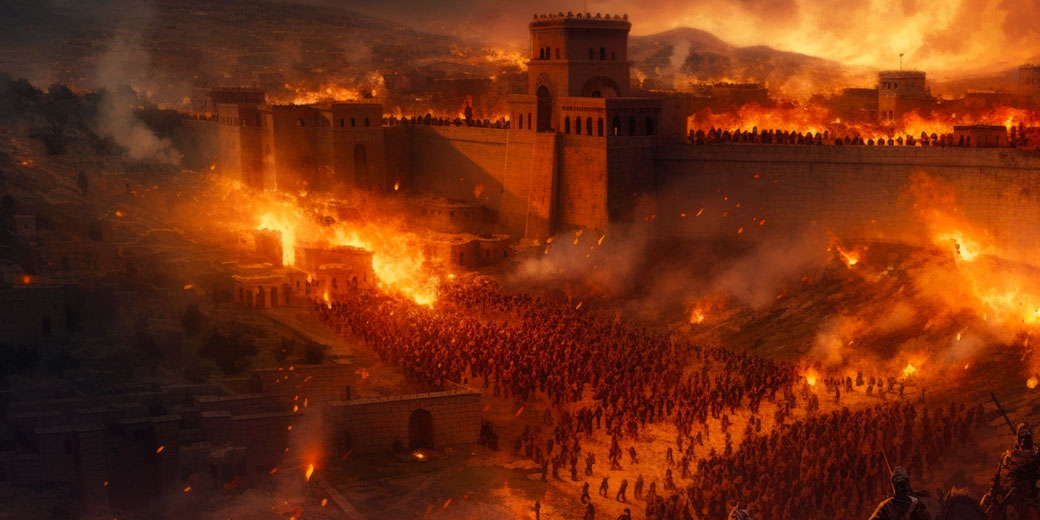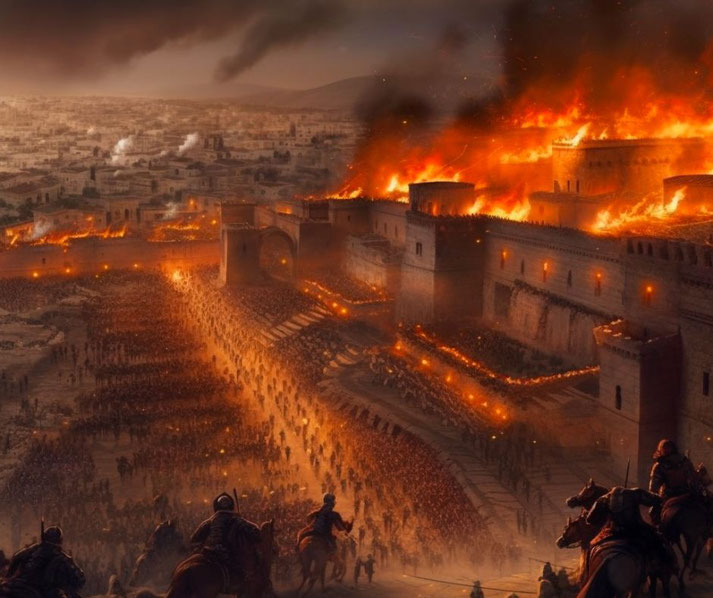The cataclysmic siege of Jerusalem in AD 70 and its impact on Judaism and Christianity

The Fall of Jerusalem in AD 70 marks a significant and deeply consequential event in both Jewish and Roman history.
This cataclysmic event signaled the end of the First Jewish-Roman War, culminating in the destruction of the Second Temple, the heart of Jewish religious, political, and cultural life.
The fall and its aftermath reshaped the Jewish diaspora, influenced the development of both Judaism and Christianity, and marked a victorious yet tumultuous period in the Roman Empire.
Simmering tensions between the Jews and Romans
In the years leading up to AD 70, Jerusalem held immense significance as the political, cultural, and spiritual center of Jewish life.
The Second Temple, built after the return from the Babylonian Exile in the 6th century BC, stood as the focal point of Jewish religious worship.
Judea, the region surrounding Jerusalem, became a client kingdom of Rome in 63 BC after Roman general Pompey's successful siege of Jerusalem.
Over the next several decades, the relationship between Rome and its Jewish subjects was fraught with tension.
A series of Roman governors, perceived by many Jews as corrupt and insensitive to Jewish laws and traditions, exacerbated these tensions.
Additionally, heavy taxes imposed by Rome fueled discontent among the Jewish populace.
The Jewish Revolt (66-70 AD)
The First Jewish-Roman War, often referred to as the Jewish Revolt, began in AD 66.
The revolt was a reaction to a series of political and religious tensions, including instances of Roman misrule and a growing nationalistic fervor among Jewish factions.
The revolt initially saw success for the Jewish rebels, who managed to expel the small Roman garrison stationed in Jerusalem.
However, Rome soon dispatched a larger force to quell the rebellion, setting the stage for the siege and eventual fall of Jerusalem.
The key power-players
Vespasian: The Roman Emperor
Vespasian was the Roman Emperor who initiated the campaign against the Jewish revolt in AD 66. However, during the course of the war, he was called back to Rome amidst a political crisis and subsequently rose to power as emperor in AD 69, leaving his son Titus in charge of the Judean campaign.
Titus: The Roman General
Titus, son of Vespasian, was the Roman general who led the siege and destruction of Jerusalem in AD 70. He had been serving under his father in the campaign against the Jewish revolt and took command after Vespasian returned to Rome. Titus was known for his military skill and leadership, which was critical in the successful but brutal siege of Jerusalem.

Josephus: The Historian and Witness
Flavius Josephus, originally Yosef ben Matityahu, was a Jewish historian and military leader turned Roman citizen. He initially fought against the Romans during the revolt but surrendered and became a prisoner.
Eventually, he won the favor of Vespasian and served as his interpreter and advisor. Josephus wrote a comprehensive account of the Jewish Revolt, including the Fall of Jerusalem, in his work "The Jewish War".
His works provide one of the most detailed contemporary accounts of this period, although they must be read critically, considering his complex personal history and the potential for bias.
Jewish Leaders and Factions
At the time of the revolt and the siege, Jerusalem was not unified under a single leader but was home to several Jewish factions.
These included the Zealots, militant nationalists who played a significant role in initiating the revolt against Rome; the Pharisees, who were experts in Jewish law and had a significant religious following; and the Sadducees, who were largely aristocratic priests.
The lack of unity and infighting among these groups contributed to the difficulty in mounting a cohesive defense against the Romans.
The Siege of Jerusalem
In the spring of AD 70, Titus gathered his forces around Jerusalem. His army consisted of about 60,000 men, including Roman legionaries, auxiliaries, and troops provided by regional allies.
The Roman forces were well-equipped and experienced, having been engaged in the Jewish Revolt for several years.
Inside the city, the Jewish defenders were in a state of disarray due to infighting among different factions. Despite this, they had prepared for the siege by storing food and fortifying the city's walls.
Jerusalem's geographical position on high ground and its formidable fortifications presented a significant challenge to the Roman attackers.
The siege lasted approximately five months. Initially, the Romans attempted to breach the city walls using siege towers and battering rams.
When this failed, they resorted to a blockade, aiming to starve the city into submission.
The conditions within the city quickly became desperate.
Food and water supplies dwindled, and disease spread among the inhabitants. Infighting among the Jewish factions also continued, further weakening the city's defenses.
In the summer of AD 70, the Romans finally managed to breach the Third Wall, then the Second, and finally penetrated the heavily fortified First Wall, entering the Upper City.

Slaughter and Destruction
One of the most significant and heart-wrenching events during the fall of Jerusalem was the destruction of the Second Temple.
According to historical accounts, the Roman soldiers set the Temple on fire, disregarding Titus's orders to spare it.
The Temple, a magnificent structure considered the heart of Jewish religious life, was reduced to ashes.
This event occurred on the 9th day of the Hebrew month of Av, a date that is still observed by Jews today as Tisha B'Av, a day of mourning and fasting.
The fall of Jerusalem was also accompanied by significant loss of life. Josephus provides an account of the carnage, stating that the Romans killed many of the city's inhabitants.
The exact numbers are disputed and likely exaggerated in Josephus' account, but it is clear that the scale of the massacre was substantial.
Those who were not killed were taken as slaves, with many sent to the mines of Egypt or sold in slave markets.
The city of Jerusalem was thoroughly sacked by the Romans. Buildings, homes, and walls were torn down, leaving the city in ruins.
The level of devastation was such that Josephus claimed that those who visited the city after its destruction could scarcely believe it had ever been inhabited.
The Romans also carried off the treasures of the Temple as spoils of war, including the Menorah, which was famously depicted on the Arch of Titus in Rome.

The widespread impacts of the fall
The fall of Jerusalem had dire immediate consequences for the Jewish people. Thousands had been killed during the siege, and those who survived faced enslavement, exile, or life in a ruined city.
The loss of the Second Temple was particularly devastating, as it was not only the center of religious worship but also a symbol of national identity.
It marked the beginning of a long diaspora for Jewish people. With the city in ruins and the Second Temple destroyed, many Jews were displaced, sold into slavery, or chose to leave the region.
They established communities throughout the Roman Empire and beyond, profoundly shaping the Jewish experience and identity.
With the destruction of the temple, the practice of Judaism had to adapt, necessitating a major shift in religious practice and thought, leading to the development of Rabbinic Judaism
For the Roman Empire, the fall of Jerusalem was a significant victory, strengthening the rule of Emperor Vespasian and his son Titus.
The victory was celebrated in Rome with a triumphal procession, as depicted on the Arch of Titus, and consolidated their power after the tumultuous Year of the Four Emperors.
The destruction of Jerusalem also had a profound impact on the early Christian movement. Many followers of Jesus had fled the city before the siege, spreading their beliefs to other parts of the Roman Empire.
The destruction of the Temple and the city validated, for some, Jesus' prophetic warnings about Jerusalem's fall.
Without a central Jewish authority in Jerusalem, and with Jewish communities scattered, Christianity began to evolve as a distinct religion, increasingly separate from its Jewish roots.
But, can we trust the historical sources?
Archaeology provides crucial evidence for understanding the Fall of Jerusalem.
The burnt layer found at the archaeological sites, remnants of the city's fortifications, artifacts from the destroyed Temple, and the Roman siege works at Masada all contribute to our understanding of the event.
Coins inscribed with "For the Freedom of Zion" found in Jerusalem also attest to the fervor of the Jewish Revolt.
The most comprehensive account of the Fall of Jerusalem comes from Josephus, a complex figure who switched his allegiance from the Jewish rebels to the Romans.
While his works provide valuable details, they must be read critically and corroborated with other sources, if available, due to potential bias.
Josephus was writing for a Roman audience and was dependent on Roman patronage, which may have influenced his portrayal of events and individuals.
What do you need help with?
Download ready-to-use digital learning resources
Copyright © History Skills 2014-2024.
Contact via email
With the exception of links to external sites, some historical sources and extracts from specific publications, all content on this website is copyrighted by History Skills. This content may not be copied, republished or redistributed without written permission from the website creator. Please use the Contact page to obtain relevant permission.





